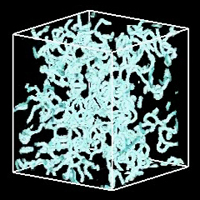Turbulent Lagrangian dynamics of vortex and magnetic-field line
Duration: 33 mins 57 secs
Share this media item:
Embed this media item:
Embed this media item:
About this item

| Description: |
Eyink, GL (Johns Hopkins)
Thursday 02 October 2008, 10:30-11:00 |
|---|
| Created: | 2008-10-23 10:23 | ||
|---|---|---|---|
| Collection: | The Nature of High Reynolds Number Turbulence | ||
| Publisher: | Isaac Newton Institute | ||
| Copyright: | Eyink, GL | ||
| Language: | eng (English) | ||
| Credits: |
|
||
| Abstract: | We do not understand the laws of motion of vortex and magnetic-field lines in high-Reynolds-number turbulent flows. The current lore is self-contradictory. On the one hand, vortex/magnetic-field lines are often assumed to wander and elongate nearly as material lines in the limit of small viscosity/resistivity, and thus also to intensify, as a consequence of the Kelvin/Alfvén theorems. On the other hand, the topology of the lines is assumed to be continuously altered by viscous/resistive reconnection, implying breakdown of those same theorems. We discuss experimental and numerical evidence that these laws are both sometimes observed and sometimes violated in high-Reynolds-number turbulence. Unfortunately, we have no rational criterion to say when the Kelvin/Alfvén theorems or the Helmholtz laws of ``frozen-in'' motion should hold and when they should not. The problem has grown more perplexing with the theoretical discovery of "spontaneous stochasticity" for Lagrangian particle evolution in a Kolmogorov inertial range. As a consequence of the forgetting of initial separations in Richardson pair-diffusion, Lagrangian trajectories are not unique and must be replaced with random distributions of trajectories in the limit of small viscosity. This result presents a major crisis to our understanding of the turbulent dynamics of vortex/magnetic-field lines. As a possible resolution, we discuss a conjectured generalization of the Kelvin/Alfvén theorems, namely, that they survive as "backward martingales" of the spontaneous stochastic flows at high Reynolds-number. This conjectured relation provides a precise mathematical framework for the theory of turbulent reconnection. We discuss current rigorous results related to the conjecture and also important questions for investigation by experiment and simulation.
A seminar from the Inertial-Range Dynamics and Mixing conference in association with the Newton Institute programme: The Nature of High Reynolds Number Turbulence www.newton.ac.uk/programmes/HRT/seminars/ |
|---|---|
Available Formats
| Format | Quality | Bitrate | Size | |||
|---|---|---|---|---|---|---|
| MPEG-4 Video | 480x360 | 1.83 Mbits/sec | 467.87 MB | View | Download | |
| WebM | 450x360 | 769.54 kbits/sec | 190.51 MB | View | Download | |
| Flash Video | 480x360 | 804.24 kbits/sec | 200.57 MB | View | Download | |
| iPod Video | 480x360 | 503.24 kbits/sec | 125.51 MB | View | Download | |
| QuickTime | 384x288 | 844.64 kbits/sec | 210.64 MB | View | Download | |
| MP3 | 44100 Hz | 125.04 kbits/sec | 30.82 MB | Listen | Download | |
| Windows Media Video | 475.4 kbits/sec | 118.56 MB | View | Download | ||
| Auto * | (Allows browser to choose a format it supports) | |||||

